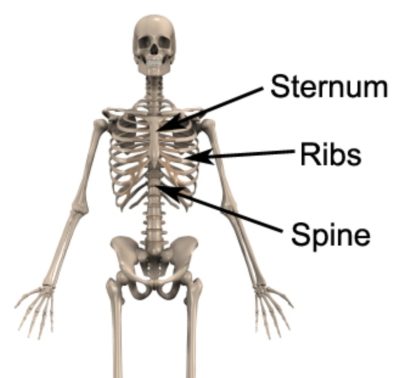Rib Anatomy
Updated:
As one of the essential components of the human skeletal system, ribs play a crucial role in protecting vital organs such as the heart and lungs. Understanding rib anatomy is important, especially if you have suffered from an injury or rib fracture.
Rib Anatomy: The Basics
Each human has 24 ribs, with 12 on each side of the chest. They attach to the spine and wrap around the chest to connect to the sternum (breastbone). The first seven pairs of ribs, called the true ribs, connect directly to the sternum, while the next three pairs, known as the false ribs, attach to the sternum indirectly. The last two pairs of ribs, the floating ribs, do not connect to the sternum at all.

Bony Landmarks of Ribs
Each rib has two main bony landmarks: the head and the tubercle. The head of the rib connects to the thoracic vertebrae of the spine, while the tubercle connects to a transverse process of the thoracic vertebrae. Additionally, the costal groove runs along the inner surface of each rib, housing the intercostal nerve and blood vessels.
Muscular Attachments
The ribs have several muscular attachments that are important for breathing and movement. The diaphragm, a large dome-shaped muscle located at the bottom of the ribcage, contracts and relaxes to help with inhalation and exhalation. The external intercostal muscles, located between the ribs, also assist in breathing by elevating the ribs during inhalation. The internal intercostal muscles are responsible for lowering the ribs during exhalation.
Rib Injuries: Causes and Symptoms
Rib fractures and rib contusions are common injuries and can occur due to a variety of reasons, including car accidents, falls, and sports injuries (usually involving a directly blow). Occasionally a rib stress fracture may develop due to overuse. Symptoms of a rib fracture include pain when taking deep breaths, tenderness at the injury site, and difficulty moving or twisting the torso. In some cases, rib fractures can also lead to other complications such as a collapsed lung or pneumonia.
Conclusion
Understanding rib anatomy is essential for identifying and treating rib fractures. With 24 ribs and various bony landmarks and muscular attachments, these structures play a crucial role in protecting vital organs and facilitating breathing. If you experience symptoms of a rib fracture, seek medical attention promptly to avoid further complications.
References
- “Rib Fractures: How to Heal a Broken Rib” by Healthline (https://www.healthline.com/health/broken-rib)
- “Ribs” by Teach Me Anatomy (https://teachmeanatomy.info/thorax/bones/ribcage/)
- “Broken Ribs” by Mayoclinic (https://www.mayoclinic.org/diseases-conditions/broken-ribs/symptoms-causes/syc-20350763#:~:text=A%20broken%20rib%20occurs%20when,broken%20ribs%20are%20simply%20cracked.)

Link to this Page
If you would like to link to this article on your website, simply copy the code below and add it to your page:
<a href="https://physioadvisor.com.au/rib-anatomy”>Rib Anatomy – PhysioAdvisor.com</a><br/>Learn about rib anatomy including bony landmarks, muscular attachments and common injuries on PhysioAdvisor.
Return to the top of Rib Anatomy.
